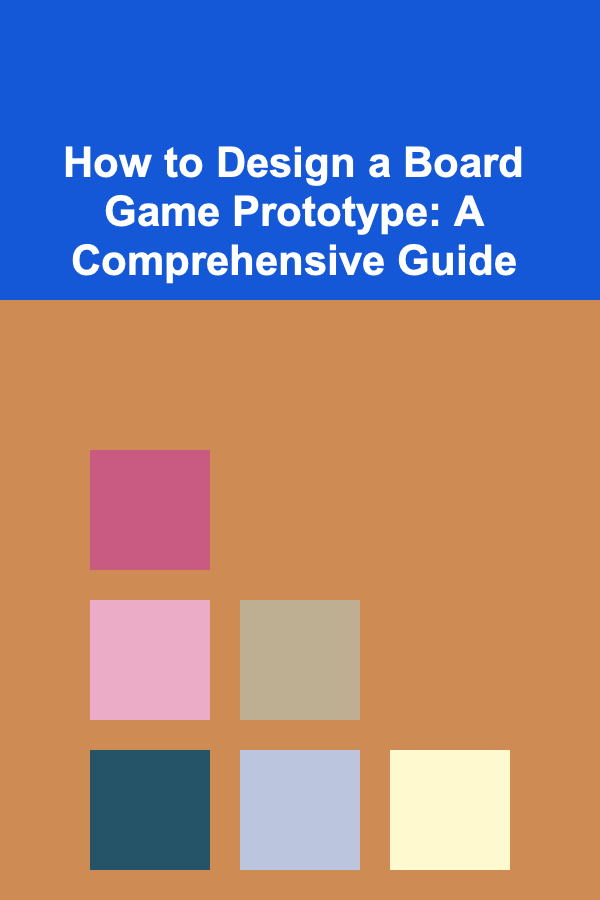
How to Design a Board Game Prototype: A Comprehensive Guide
ebook include PDF & Audio bundle (Micro Guide)
$12.99$8.99
Limited Time Offer! Order within the next:

Creating a board game is a challenging but incredibly rewarding endeavor. The journey from initial idea to a polished, playable game involves numerous iterations, testing, and refinement. A crucial step in this process is designing a prototype. This guide provides a detailed and comprehensive roadmap for creating effective board game prototypes, enabling you to iterate quickly and efficiently, ultimately leading to a more engaging and well-balanced game.
Phase 1: Conception and Core Mechanics
The initial phase is all about solidifying your game's core identity. Before even thinking about components, you need a clear vision of what kind of experience you want to create.
1. Define Your Game's Essence
Start by answering some fundamental questions about your game:
- What is the core gameplay loop? This is the repeating cycle of actions players will perform throughout the game. Examples include drawing cards and playing them, moving pieces and resolving combat, or collecting resources and building structures.
- What is the win condition? How do players achieve victory? Is it through accumulating points, being the last player standing, completing a specific objective, or controlling a certain territory?
- What feeling do you want players to experience? Is it a sense of strategic planning, tense competition, collaborative teamwork, or emergent storytelling? The emotional experience is a vital part of the overall design.
- Who is your target audience? Consider age range, experience level with board games, and preferred genres. Designing for children requires different considerations than designing for experienced gamers.
Having a clear answer to these questions will serve as a guiding principle throughout the entire development process. It will help you make informed decisions about mechanics, theme, and components.
2. Brainstorm Core Mechanics
Now that you have a sense of your game's essence, start brainstorming the mechanics that will bring it to life. Don't be afraid to experiment and explore different possibilities.
- Consider existing mechanics: Draw inspiration from games you enjoy. Think about how mechanics like worker placement, deck-building, area control, or dice rolling could be adapted to fit your game.
- Invent new mechanics: Don't limit yourself to what already exists. Try to come up with unique and innovative ways to challenge and engage players. This is where true creativity can shine.
- Keep it simple: At this stage, focus on a small set of core mechanics. It's easier to build upon a solid foundation than to try and wrangle a complex system from the start. Aim for elegance and efficiency in your core mechanics.
Write down all your ideas, even the seemingly outlandish ones. You can always refine and discard them later.
3. The Power of Theme
While mechanics are the engine of your game, theme provides the context and narrative that makes it engaging. An integrated theme can enhance player immersion and make the game more memorable.
- Choose a theme that complements your mechanics: The theme should naturally integrate with the gameplay. A game about building a city, for example, might logically involve resource management and strategic placement of buildings.
- Consider your target audience: What themes will appeal to them? A space exploration theme might resonate with science fiction enthusiasts, while a historical theme might appeal to history buffs.
- Don't force it: If you're struggling to find a theme that fits your mechanics, it might be better to focus on the mechanics first and add a theme later, or even abstract the game entirely. A poorly integrated theme can detract from the gameplay experience.
A strong theme can provide a framework for your game's story, characters, and components, making it more compelling and immersive.
Phase 2: Prototyping and Iteration
This is where your ideas take physical form. The goal is to create a playable version of your game as quickly and cheaply as possible. Don't worry about aesthetics at this stage; focus on functionality and playability.
1. Low-Fidelity Prototyping: Embrace the Imperfect
Your first prototype should be extremely basic. Think index cards, dice from other games, and hand-drawn boards. The point is to test your core mechanics quickly without investing too much time or money.
- Use readily available materials: Index cards, paper, pencils, dice, coins, meeples from other games, and even Lego bricks can be used to represent game components.
- Keep it abstract: Don't worry about creating beautiful artwork or detailed miniatures. Focus on the functionality of the components. For example, instead of drawing a knight, just write "Knight" on a card.
- Label everything clearly: Make sure all components are clearly labeled with their function and purpose. This will make it easier for you and your playtesters to understand the game.
The low-fidelity prototype is all about speed and flexibility. You should be able to make changes quickly and easily as you test and iterate.
2. Create a Rules Document (Even a Basic One)
Even though your prototype is basic, you need a clear set of rules to guide gameplay. This doesn't have to be a polished rulebook, but it should cover the essential aspects of the game.
- Outline the game's objective: Clearly state how players win the game.
- Explain the setup: Describe how the game is set up, including the placement of components and the distribution of resources.
- Detail the turn structure: Explain what actions players can take on their turn and the order in which they must be performed.
- Define component functions: Explain the purpose and function of each component in the game.
- Address potential ambiguities: Anticipate any questions or ambiguities that might arise during gameplay and provide clear answers.
A well-written rules document will make it easier for you and your playtesters to understand the game and provide meaningful feedback.
3. Playtesting: The Heart of the Process
Playtesting is the most crucial part of game design. It's where you discover what works, what doesn't, and what needs to be improved. Don't be afraid to get your game in front of players as early as possible.
- Playtest with yourself first: This will help you identify any obvious flaws or inconsistencies in the rules.
- Recruit playtesters: Start with friends and family, then expand to more experienced gamers. Look for playtesters who are willing to provide honest and constructive feedback.
- Observe and listen: Pay close attention to how players interact with the game. Listen to their comments and suggestions, even if they seem trivial. Nonverbal cues like frustrated expressions or confused looks can be just as informative as verbal feedback.
- Don't interfere: Avoid interrupting the game unless absolutely necessary. Let players figure things out for themselves. This will give you a better understanding of how intuitive the game is.
- Take notes: Record your observations and playtesters' feedback. Note any rules that were unclear, mechanics that felt clunky, or moments of frustration. Organize your notes in a way that makes it easy to track patterns and trends.
Remember that playtesting is not about defending your design; it's about learning and improving it. Be open to criticism and willing to make changes.
4. Iterate, Iterate, Iterate
Based on the feedback you receive from playtesting, make changes to your prototype and rules. This is an iterative process, so don't expect to get it right on the first try. Be prepared to make numerous changes as you refine your game.
- Prioritize feedback: Focus on addressing the most significant issues first. For example, if players consistently struggle to understand a particular rule, that should be your top priority.
- Make small changes at a time: Avoid making too many changes at once, as this can make it difficult to isolate the effects of each change.
- Test each change thoroughly: After making a change, playtest the game again to see how it affects the overall experience.
- Track your changes: Keep a record of all the changes you make and the reasons for making them. This will help you track your progress and avoid repeating mistakes.
Iteration is the key to creating a great game. The more you test and refine your design, the better it will become.
Phase 3: Refining and Polishing
Once you've iterated on your prototype several times and you're happy with the core mechanics and gameplay, it's time to start refining and polishing the game. This involves improving the visual presentation, balancing the mechanics, and writing a clear and comprehensive rulebook.
1. High-Fidelity Prototyping: Aesthetics Matter (Now!)
Now that the core gameplay is solid, you can start to improve the visual presentation of your prototype. This doesn't mean you need to hire a professional artist, but you should aim for a more polished and visually appealing look.
- Improve the artwork: Use simple graphics software to create more professional-looking artwork for your cards and board. Even simple icons and symbols can significantly enhance the visual appeal of the game.
- Upgrade the components: Replace the placeholder components with more durable and aesthetically pleasing ones. You can find a wide variety of board game components online, such as wooden meeples, custom dice, and plastic tokens.
- Print a nicer rulebook: Format your rules document in a more professional manner and print it out on high-quality paper. Include diagrams and illustrations to help explain the rules.
A more polished prototype will make a better impression on playtesters and potential publishers.
2. Balancing the Game: A Delicate Art
Game balance is the process of ensuring that all players have a fair chance of winning and that no single strategy is overwhelmingly dominant. This requires careful analysis and testing.
- Track player performance: Keep track of how often each player wins the game. If one player consistently wins, it may indicate that there is an imbalance in the game.
- Analyze player strategies: Identify any strategies that seem to be particularly effective. If one strategy is significantly more powerful than others, it may need to be nerfed.
- Adjust component values: Adjust the values of components, such as resource costs, attack strengths, or movement speeds, to create a more balanced game.
- Introduce handicaps: If you're playing with players of different skill levels, consider introducing handicaps to level the playing field.
Balancing a game is an ongoing process. You may need to make adjustments even after the game is published.
3. Writing a Comprehensive Rulebook: Clarity is Key
A clear and comprehensive rulebook is essential for a successful board game. The rulebook should explain all aspects of the game in a clear and concise manner, leaving no room for ambiguity.
- Organize the rules logically: Structure the rulebook in a way that makes sense and is easy to navigate. Use headings, subheadings, and bullet points to break up the text.
- Use clear and concise language: Avoid using jargon or technical terms that players may not understand. Define any terms that are essential to understanding the game.
- Provide examples: Use examples to illustrate how the rules work in practice. This will help players understand the rules more quickly and easily.
- Include diagrams and illustrations: Use diagrams and illustrations to visually explain complex concepts.
- Proofread carefully: Thoroughly proofread the rulebook to catch any errors in grammar, spelling, or punctuation.
A well-written rulebook will make it easier for players to learn and enjoy your game.
4. Blind Playtesting: The Ultimate Test
Blind playtesting is when you give your prototype and rulebook to a group of playtesters who have never played the game before and observe them as they play. This is the ultimate test of the clarity and completeness of your rules.
- Provide minimal instruction: Give the playtesters the prototype and rulebook and tell them to play the game. Avoid providing any additional instruction or guidance.
- Observe and take notes: Pay close attention to how the playtesters interact with the game. Note any rules that they struggle to understand or any ambiguities that arise.
- Answer questions only when necessary: Only answer questions if the playtesters are completely stuck and unable to proceed.
Blind playtesting will reveal any remaining flaws in your rules or gameplay. Use the feedback you receive to make final adjustments before presenting your game to publishers.
Phase 4: Presentation and Next Steps
You've created a compelling prototype, refined the mechanics, and written a clear rulebook. Now it's time to think about how to present your game to potential publishers or pursue self-publishing options.
1. Creating a Sell Sheet: Your Game's Resume
A sell sheet is a one-page document that summarizes the key features of your game and is used to pitch it to publishers. It should be visually appealing and contain all the information a publisher needs to decide whether or not to take a closer look at your game.
- Game Title and Designer: Clearly state the name of your game and your name as the designer.
- Brief Description: Provide a concise overview of the game, highlighting its unique selling points.
- Target Audience: Specify the age range and experience level for which the game is intended.
- Number of Players and Playing Time: Indicate the ideal number of players and the average playing time.
- Key Mechanics: List the key mechanics that are used in the game.
- Compelling Artwork: Include high-quality images of your prototype and any artwork you've created.
- Contact Information: Provide your contact information so that publishers can reach you.
A well-crafted sell sheet is essential for getting your game noticed by publishers.
2. Pitching to Publishers: Making a Strong Impression
Pitching your game to publishers can be intimidating, but it's an essential step in getting your game published. Be prepared to present your game clearly and confidently.
- Research Publishers: Identify publishers who publish games in your genre and target audience.
- Prepare a Pitch: Practice your pitch so that you can present your game clearly and concisely.
- Bring Your Prototype: Bring a polished prototype of your game to the meeting.
- Be Professional: Dress professionally and be respectful of the publisher's time.
- Be Prepared to Answer Questions: Be prepared to answer questions about your game, your design process, and your marketing strategy.
- Follow Up: Send a thank-you note after the meeting and follow up periodically to check on the status of your submission.
Remember that rejection is a part of the process. Don't be discouraged if your game is rejected by a publisher. Keep refining your design and keep pitching until you find the right publisher for your game.
3. Self-Publishing: Taking Control
If you're unable to find a publisher for your game, you can consider self-publishing it. This gives you complete control over the design, production, and marketing of your game.
- Consider the Costs: Self-publishing can be expensive, so be sure to factor in the costs of printing, components, artwork, marketing, and distribution.
- Choose a Printing Service: Research different printing services and choose one that offers high-quality printing at a reasonable price.
- Create a Marketing Plan: Develop a marketing plan to promote your game to potential customers. Use social media, online advertising, and board game conventions to reach your target audience.
- Handle Fulfillment: Decide how you will handle fulfillment. You can either fulfill orders yourself or hire a fulfillment service.
Self-publishing can be a challenging but rewarding experience. It gives you the opportunity to bring your vision to life and share your game with the world.
Conclusion
Designing a board game prototype is a complex but ultimately rewarding process. By following the steps outlined in this guide, you can create a playable prototype that will allow you to test your ideas, gather feedback, and refine your design. Remember to embrace iteration, prioritize playtesting, and never be afraid to make changes. With perseverance and dedication, you can turn your board game dream into a reality.

Essential Librarian: A Comprehensive Guide to Library Management and Services
Read More
Public Health Specialist's Handbook: Navigating Policy, Research, and Community Engagement
Read More
How to Master Social Media for B2B Marketing
Read More
How to Analyze the Symbolism of Props in Film
Read More
How to Plan Healthy Snacks for the Day
Read More
Decoupage on Canvas: Exploring Mixed Media Techniques
Read MoreOther Products

Essential Librarian: A Comprehensive Guide to Library Management and Services
Read More
Public Health Specialist's Handbook: Navigating Policy, Research, and Community Engagement
Read More
How to Master Social Media for B2B Marketing
Read More
How to Analyze the Symbolism of Props in Film
Read More
How to Plan Healthy Snacks for the Day
Read More